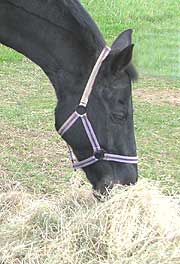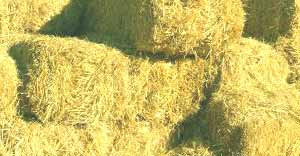Feeding Hay to Horses and Ponies
 High quality hay can be an excellent
source of
nutrition for - including protein and calcium
- for horses and ponies and is a very
palatable feed.
High quality hay can be an excellent
source of
nutrition for - including protein and calcium
- for horses and ponies and is a very
palatable feed.
There are many types of hay harvested from grasses including alfalfa,
timothy, clover and rye.
Many horse owners advise that Alfalfa hay
is the best kind of hay to feed a horse.
Horses and ponies in their natural environment are
grazing animals - they spend many hours a day eating grass.
When horses are stabled, or grazing is limited, they
need a substitute for the grass they would have naturally eaten. Hay
, the most common subsitute- is a mixture of grasses dried until
only about 18% of the moisture remains.
The most nutritious hay is that cut before the seed
heads have fully matured.
Grass and hay provide your horse or pony with the large
amounts of fibre he needs keep his gut healthy and digestive system functioning
properly. They should be the predominant type of feed in a horse's diet.
If your horse or pony is stabled making hay available all the times
can help to prevent vices such as weaving and crib biting as it prevents
boredom and encourages his natural foraging habits.
Most horses will self-regulate the amount of hay that
they eat. But some will need their hay restricted to prevent them becoming
overweight.
Many people will soak their horse's hay before feeding to remove dust and
spores which can cause coughing.
Unfortunately soaking hay can reduce the nutritional value of hay, as up to
70% of water- soluble carbohydrates and 20% of protein is lost during
this process. A better alternative is to
steam hay
If your horse develops a
cough when fed dry hay it may be worth considering switching to HorseHage,
Haylage or a similar equine product.
Benefits of feeding
hay
- Hay provides the fibre needed to keep
the horse's digestive system functioning properly.
- Provides vitamins and nutrients
- Keeps weight on your horse or pony.
|
Daily amount
of hay to feed a horse
A horse should eat approximately12-15 pounds
of hay a day - about 2 pounds of hay per
day for every 100 pounds of a horse's body weight.
This amount is a rough average - a horse or pony needs will
vary depending on their workload, metabolism, time of the
year, the quality and amount of grazing that they have access
to and what "hard food" they are being fed.
Ponies will require a lot less hay , while
large draft horse breeds can eat more than 30 pounds of hay
a day, a 12hh pony in light exercise usually requires only
about 9lb a day.
Common sense prevails here. As long as your horse or pony
is not overweight it is OK to feed him as much as he wants
- most horses will not eat more than they need.
Put the hay in a haynet
and weigh it on spring balance scales with a hook hanging
down and a dial - very cheap to buy. After a while you begin
to develop a feel for what weighs "right" regardless of volume.
If your horse never leaves any waste hay he probably isn't
getting quite enough for his liking! |
Soaking hay
Soaking your horse's
hay before feeding can control the dust
and mould spores which cause "hay coughs" and aggaravate
COPD.
Some owners also soak hay to actually remove some of the
nutritional value including sugars and starches when feeding
overweight horses and ponies.
If you soak hay to remove dust and spores do so in clean
water for between 30 minutes and 1 hour.
20 - 30 minutes of soaking sticks spores to the hay stalks
so that they cannot be inhaled by the horse
1 -2 hours of soaking swells the spores so that they cannot
be inhaled by the horse.
Any longer than 2 hours of soaking greatly reduces the nutritonal
value of hay.
Soak the hay in a bath or tub or water. Allow to drain before
feeding.
Dispose of the waste soaking water carefully as it is a
pollutant similar to sewage.
If you have a kettle available, a good method is to put a
haynet full of hay in a bin or bath and pour boiling water
over it .
The steam swells up the fungal spores more quickly, and
there is less waste water to dispose off and less nutrition
is lost.
Steamers are available specially manufactured for steaming
hay.
If you are soaking the hay because it is of poor
quality then you'd really be better to not feed that hay. |
|
 |
Choosing the best
type of hay for your horse
Good hay should smell sweet and be free
of mould, dust or poisonous weeds - especially
ragwort.
Hay to be fed to a horse should have fine stems and lots
of leaves
Mouldy hay smells musty and has white, brown or grey patches.
Do not feed it to your horse! It can cause coughs,
respiratory disease and colic.
Any hay can become mouldy because of harvesting
or storage problems.
In some countries, especially North America, Blister
Beetles are to be found in hay.
Hay containing Blister Beetles should not be fed to horses. |
Types of hay
Good quality hay can contain many types of grasses and foliage
including:
- Clover
- Alfalfa
- Rye Grass
- Timothy
- Fescue
- Cocksfoot
|
HOW TO FEED
HAY
- Haynet. be sure the net is tied safely
and is high enough so that your horse can't get a leg caught
in it.
- Hayrack
- On the floor / from the ground - the
most natural way for a horse to eat! However this can be
a very wasteful way to feed hay
|
Vitamins in hay
Hay contains high levels of vitamins A, E, K, and D.
However, hay that is a year old will have a low vitamin
content since vitamins in hay break down with time. |
WARNINGS!
- If you use a haynet make sure that the
net is tied safely with a quick release knot and is high
enough so that your horse can't get a leg caught in it.
- Bales are held together by string or wire; be sure to
remove these after cutting open a bale of hay.
- Never feed feed mouldy or dusty hay. This can cause coughs,
respitory illnesses and colic.
- Make sure that the hay doesn't contain poisonous weeds.Keep
a special lookout for ragwort.
|
|
Advice about the best way of feeding hay to a horse or pony,
different types of hay
 High quality hay can be an excellent
source of
nutrition for - including protein and calcium
- for horses and ponies and is a very
palatable feed.
High quality hay can be an excellent
source of
nutrition for - including protein and calcium
- for horses and ponies and is a very
palatable feed.